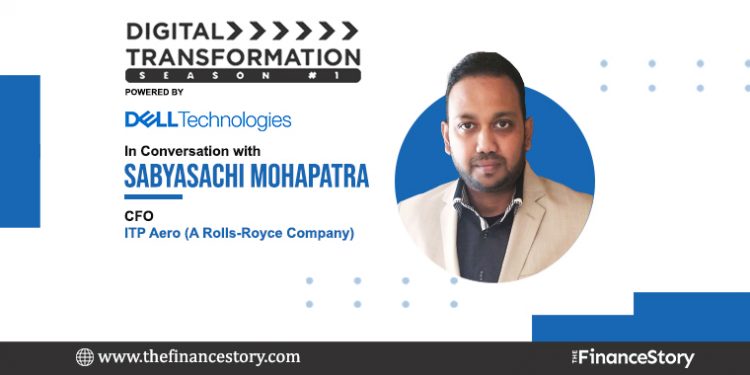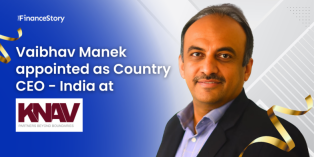- Meet Sabyasachi Mohapatra, the CFO of ITP Aero, India (A Rolls-Royce Company) and a finance professional, who went from operating with small start-ups to scaling large businesses.
- With the advancement in technology, his role as a CFO has increased manifold.
- As part of the Digital Transformation series powered by Dell Technologies, we spoke to Sabyasachi to understand his journey in exploring technology and administering his role across various functions within the company.
Tell us about yourself
I completed my graduation in Instrumentation engineering in 2001. Unfortunately, around that time, the entire job market was impacted due to the 9/11 crisis. Since there were very few good job opportunities in the market, I decided to do an MBA in Finance (instead of struggling to find a job). Post my MBA, I got opportunities in various finance roles and there has been no turning back.
Today I have almost two decades of experience in managing functions like Finance and Accounts, Human Resources, Information Technology, Supply Chain, and Administration.
I have worked with numerous organizations across sectors including the manufacturing and service sectors. I have operated with small start-ups and worked diligently to grow their organization. On the other hand, I have worked with large and multi-national organizations too.
Since 2019 I have been a CFO at ITP Aero India – a Spanish aero engine and gas turbine manufacturer.
While my designation still continues as a CFO, my responsibilities range across multifarious functions which include HR, IT, supply chain, procurement, and admin.
What is digital transformation for you?
For me, digital transformation (digitalization) is a tool to enable multiple functions of operations to work closely with better coordination resulting in improved efficiency.
Digitalization is enabling, efficient information sharing on a real-time basis among various departments and locations to improve overall efficiency and reduced costs.
Digital transformation for a manufacturing company like ITP Aero is a combination of traditional manufacturing processes enhanced with new advancing technologies, working together to drive manufacturing forward and address inefficiencies in the current sector.
What is the role of technology in a business like yours?
ITP Aero is a company is into manufactures aircraft engines, defense cargo aircraft engines, and fighter aircraft engines. Specifically, we are engaged in manufacturing aircraft engines for large commercial aircraft manufacturers.
In India, we manufacture approximately 350-400 Components that are used in the assembly of Aircraft Engines.
Considering the nature of our business technology is the lifeblood of our business and we invest heavily in technology R&D. The focus of these investments has been on new technologies and capabilities that will improve engine efficiency, significantly reduce carbon emissions, and minimize adverse environmental impacts – including noise. In fact, we passed a number of significant milestones on our new engine programs.
As far as IT is concerned in India, we are using technology to bring about efficiencies in production and cost. We are currently using SAP S4 HANA as the integrated ERP for business operations spread across 29 legal entities spread across the world.
Apart from SAP, there is various manufacturing and designing software used as per requirement and subsequently integrated into the mother ERP.
We also use various homegrown applications based on the customized need of our company. It also helps us to bring about a change in our business completely.
As a CFO, what is your role in the entire technology adoption at ITP Aero, India?
As a CFO I have a very good understanding of the day-to-day operation of every function and what is happening within the operational areas of the company.
Although I am not involved in the sales and manufacturing function directly, I have a fair understanding of its functioning too.
Since I understand the processes so well, I also understand what will be the impact of automation/technology in certain areas. Hence, not only me but in general a CFO is the best person to administer the distribution of technology in numerous departments.
Talking about my role w.t.t technology decisions at ITP Aero India, apart from the management of local IT infrastructure and troubleshooting, my role requires me to gather all new IT requirements from all the departments and take them up with the global IT team to explore solutions along with them.
We have several homegrown applications but all are developed in Spain as we have a dedicated large IT team at our HO. We deliver our detailed requirements to them but we are a part of the development of PDNs, finalization of the design documents, and testing of the product.
Currently, we are working on the in-house development of a module for the management of employee reimbursements.
Being a finance experienced professional how do you understand what decisions need to be taken w.r.t technology adoption?
I have a fair idea about technology but I do not consider myself an expert in this field. My IT colleagues are more well-versed and I am open to learning from them.
However, coming from an engineering background, I am able to understand certain facets of technology even better. From a business perspective, everything is decided when we come together and weigh the pros and cons of it.
I believe in learning new things every day as my IT team guides me in technological functions.
Is it easier for you to understand all the latest technologies being an engineer?
Having an engineering background has certainly helped me understand technology much better. However, my inherent interest in learning about new technologies from my colleagues/ service providers has really helped me keep myself updated with the latest changes.
What has been the impact of the pandemic on your company?
The Aviation sector has taken one of the biggest hits along with the hospitality sector. Unfortunately, the pandemic has adversely affected us.
We are a manufacturing set-up so people do have to come to the production division. WFH option has been offered to people who can work from home.
We have ensured that proper IT tools are given to them so that proper efficiency is maintained.
People who do not have any direct involvement in production processes have been given the option to work from home. Since the majority of the workforce is involved in production activity, not many of the employees can work from home.
So, 30% of the people are able to work from home and the remaining 70% are working in the production facility as per the guidelines of social distancing.
Any new tech adoption during the pandemic? Was security a concern?
There has been no significant change in technology due to the Pandemic apart from enabling people to work from home with the right IT infrastructure, there has been no change in technology. Security was not a concern since we have taken all requisite measures to address security concerns.
How do you do the cost-benefit analysis and how do you measure the ROI when adopting technology?
If the requirement comes from the user, I would assign it to the user department itself to assimilate the points and benefits from a particular software or technology that is going to be implemented.
When technology is being pursued by an IT member, I ask them to first ask the user if they need it. The IT person takes the solution to the user to explain the benefits and the user assesses whether it is required or not. This is formulated with a 10-15 year outlook of it.
Therefore, the IT members, finance people, and the user department come together to decide what is required for the organization, the best IT solution available, and whether the organization can afford it.
Since my team is responsible for enlisting the cost-benefit factor to it we entreat the IT person to explore the market for this kind of support. There might be three vendors operating out of it. After that, we evaluate the solutions.
The technology should bring about efficiency and reduce manual inputs.
Lastly, in the next three years, what do you envision the role of a CFO as?
In the last decade or so, I have observed that the role of a COO is becoming irrelevant. I foresee that the CFO starts managing the responsibilities which the CEO does not have adequate time to personally look into. As a matter of fact, even today a lot of the supporting services have started reporting to the CFO.
Today CFOs are even more tech-savvy and they understand business. Most of them are able to make decisions concerning technology and its cost-benefit analysis of it.
So in the next few years, most of the responsibilities will be divided between the CEO and the CFO!
Now It’s Your Turn…
As a Finance Professional, what has been the impact of technology and automation in your role? Comment below and let us know.














